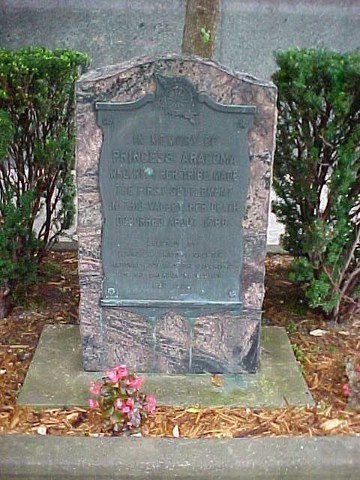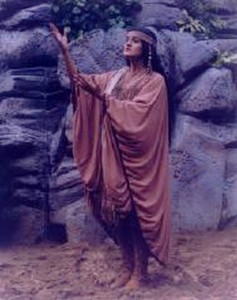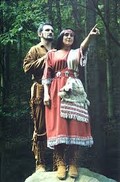Princess Aracoma Memorial
Introduction
Text-to-speech Audio
Images
The Princess Aracoma Memorial located at the Logan County Courthouse. The monument reads "In Memory of Princess Aracoma who with her tribe made the first settlement in this valley. Her death occurred about 1780.″

Princess Aracoma being portrayed by an actress.

The re-telling of the love-struck story of Aracoma and Boling Baker.

Backstory and Context
Text-to-speech Audio
As the daughter of the Shawnee Chief, Aracoma was favored among her people. It has been told that she grew into a beautiful women, standing almost six feet tall. When Aracoma was sixteen years old, in 1756, she met Boling Baker for the first time. Baker— a white renegade, horse thief, and a deserter from the British army—was taken captive by the Shawnees.3,4,5 He was brought before the Shawnee Chief, Cornstalk, and his council, and sentenced “to run the gauntlet.”6 Baker courageously accepted his fate. His courage was noticed by the young princess, who pleaded with her father to spare his life; "it is said Chief Cornstalk was kind at heart and he spared Baker from death."3 He became a member of the tribe and fell in love with Aracoma. When the two married they settled the conflict between the Shawnee and the white settlers in the region.3
It is believed that sometime after 1760 Chief Cornstalk established “The Islands” in what is now called Logan County, West Virginia. Chief Cornstalk gave his daughter, and her husband the land, as some of her people went to live under her rule.3 Her tribe resided on the bank of the Guyandotte River where they built their own Native village. It was on this island where their six children were born: Little Black Bear, born in 1761; Snow Lily, born in 1763; Running Deer, born in 1765; Laughing Water, born in 1767; Blue Feather, born in 1769; and Princess Raindrop, born in 1771.5 In 1776 tragedy struck the village when a great plague of smallpox swept through the area; all six of Princess Aracoma and Boling Baker's children died.5
In 1774, Chief Cornstalk was killed at the "Battle of Point Pleasant," and
Aracoma was given command of the Shawnee Indians. In the spring of 1780
and after the majority of the tribe had died from smallpox, Baker led a group
of Indians to raid the settlers in the New River Valley as a last resort to
survive. While Baker was absent, a raid on Aracoma's village was
led by John Breckenridge and William S. Mason. This raid came to be known
as the “Battle of the Islands.” 2 According to the website titled “Logan,
WV History and Nostalgia,” “among the wounded Indians was a woman, who from her
dress and bravery, was at once recognized as leader of the Indian party.” Aracoma
was wounded during this event, but was rumored to have said these last words to
the white settlers before she passed:
“My name is Aracoma, and I am the last of a mighty line. My father was a great chief and a friend to your people. He was murdered in cold blood by your people when he came to them as a friend to give them warning. I am wife of a pale-face who came across the great waters to make war on my people, but came to us and became one of us. I am dying, bury me with my face toward the setting sun, that I may see my people in their march to our happy hunting grounds. For your kindness, I warn you to make haste in returning to your homes, for my people are still powerful and will return to avenge my death.” 3
According to findagrave.com, a grave was uncovered in Logan, WV, which was suspected to be Aracoma’s due to the depth of her body and the location in which it was found; “the odd and haunting irony was that the skeleton was buried at the bend of the Guyandotte, almost exactly where the old and half-forgotten traditions claimed was the final resting place of Princess Aracoma.”4
Originally, current day Logan County Courthouse was named after Aracoma in 1852; however, it was changed in 1907 to align with the name of the post office.1 The love story of Princess Aracoma and Boling Baker is reenacted every summer at Chief Logan State Park, performed and produced by the local community.
Sources
Photo Source: http://gosoutheast.about.com/od/historicsitesculture/p/aracomastory.htm
